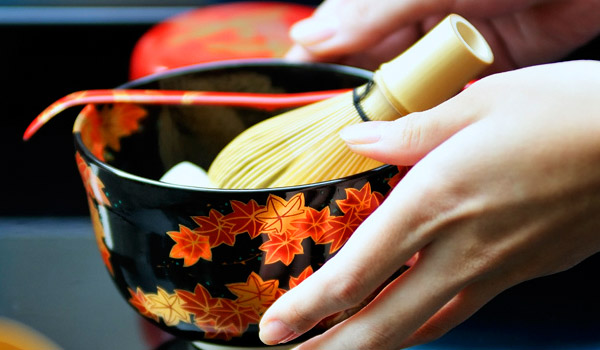The tea ceremony chado/sado is the ritualized preparation and serving of “powdered green tea” in the presence of guests. A full-length formal tea ceremony involves a meal and two servings of tea and lasts approximately four hours, during which the host engages his whole being in the creation of an occasion designed to bring aesthetic, intellectual and physical enjoyment and peace of mind to the guests.
JAPAN:
The tea ceremony chado/sado is the ritualizes preparation and serving of “powdered green tea” in the presence of guests. A full-length formal tea ceremony involves a meal and two servings of tea and lasts approximately four hours, during which the host engages his whole being in the creation of an occasion designed to bring aesthetic, intellectual and physical enjoyment and peace of mind to the guests. The objective of a tea gathering is that of Zen Buddhism – to live in this moment – and the entire rituals is designed to focus the senses so that one it totally involved in the occasion and not distracted by mundane thoughts.
CHINA:
Chinese tea ceremonies or “tea culture” vary enormously in preparation methods, tasting methods and the occasions for which it is consumed.
Gong Fu or Kung Fu Tea literally meaning “great skill tea” rather than focusing on symbolic hand gestures such as that of the Japanese tea ceremony, the taste of the tea is paramount. Although Gong Fu Cha (tea) brewing method does have uncompromising steps, it is important to note that the various Asian tea consuming cultures have added local styles and equipment, adding to the richness of the Asian tea culture.
Wu-Wo Tea Ceremony began in Taiwan. The typical interpretation of “Wu-Wo” means to empty one’s mind to the degree that it becomes like an infinite void, simply and purely just “being” without physical, mental or emotional attachments. A “circular rainbow” is the symbol for the Wu-Wo Tea Ceremony. A rainbow is made of seven basic colours which, when combined together, become white light. The Wu-Wo tea Ceremony pursues the circular the circular rainbow and goes towards the white light or empty circle in the flags centre. The theory is to try and forget everything and transcend.
Today in China, tea is enjoyed and performed as gestures of gratitude, thanks, apologies and celebration.
HIGH TEA:
Once upon a time, High Tea was an early evening meal, typically eaten between 5 and 6 O’clock. For the farmers and working class, it was eaten as a substitute for both afternoon tea and the evening meal. Using leftovers, the meal usually consisted of cold meats, eggs, fish, cakes and sandwiches. The term, “High Tea” comes from the meal being eaten at the “high” or main table, instead of the smaller lounge table. In recent years, High Tea has become a title for exquisite afternoon tea. Elegantly presented cakes, scones, finger sandwiches, along with Petite Fours, were enjoyed with a light floral afternoon tea such as, Darjeeling.

